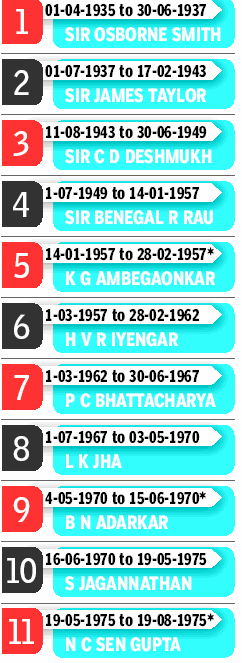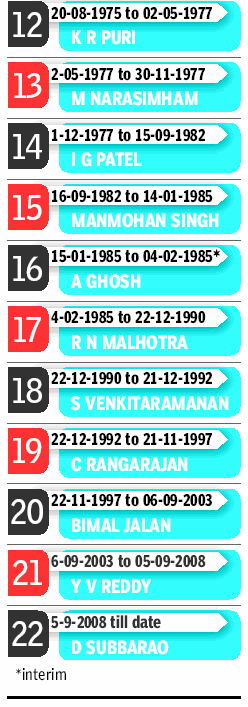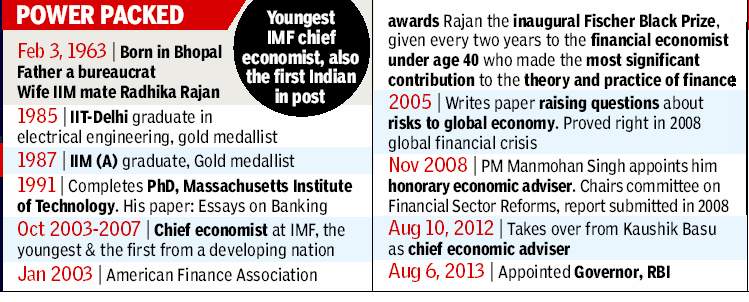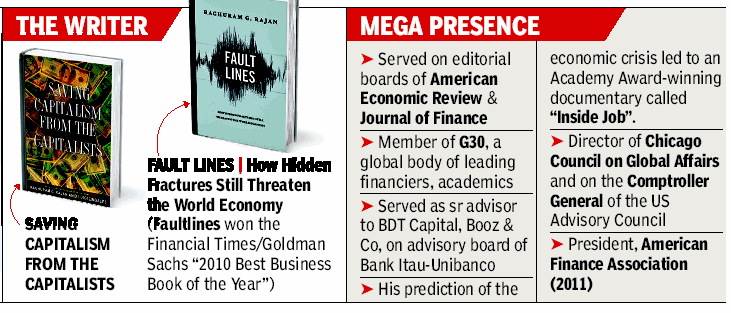The Reserve Bank of India
(→Governors of the Reserve Bank of India) |
(→Duvvuri Subbarao: 2008-2013) |
||
| Line 35: | Line 35: | ||
<br/> | <br/> | ||
| − | = Duvvuri Subbarao: 2008-2013= | + | == Duvvuri Subbarao: 2008-2013== |
Subbarao, man who fell into cauldron of woes | Subbarao, man who fell into cauldron of woes | ||
| Line 61: | Line 61: | ||
He said the RBI under Subbarao had misjudged food inflation and hiked rates. “What could’ve been a virtuous cycle has been turned into a vicious cycle,” Bhalla said. Not all would agree with such a harsh summation. | He said the RBI under Subbarao had misjudged food inflation and hiked rates. “What could’ve been a virtuous cycle has been turned into a vicious cycle,” Bhalla said. Not all would agree with such a harsh summation. | ||
| − | |||
=Raghuram Rajan: 2013-= | =Raghuram Rajan: 2013-= | ||
Revision as of 08:41, 12 March 2014
This is a collection of articles archived for the excellence of their content. Readers will be able to edit existing articles and post new articles directly |
Contents |
Policy reviews
2014: RBI shifts to bi-monthly policy review
TIMES NEWS NETWORK
Mumbai: The Reserve Bank of India will shift to a system of announcing its policy statement bi-monthly with the first such policy being announced on April 1, 2014. Bankers widely expect RBI to hold on to rates given that pressure on inflation is easing and the rupee has also been firming up.
Until the mid-90s, RBI had only two monetary policy reviews a year. After Bimal Jalan took charge as governor in 1997, he introduced quarterly reviews. His successor Y V Reddy introduced a mid-quarter review, which resulted in an announcement every 45 days.
A panel headed by RBI deputy governor Urjit Patel had recommended that the central bank monetary policy committee meet every two months to review rates.
Governors of the Reserve Bank of India
The Times of India 2013/08/07
Duvvuri Subbarao: 2008-2013
Subbarao, man who fell into cauldron of woes
Surojit Gupta | TNN
The Times of India 2013/08/07
New Delhi: For Duvvuri Subbarao it was baptism by fire when he took over the reins of the Reserve Bank of India nearly five years ago.
As soon as he stepped into the corner office at the central bank headquarters in Mumbai’s Mint Road, a tsunami struck the global financial system. The force of the 2008 global financial meltdown meant that RBI had to call on all its resources to shield the economy from being brutalized.
Subbarao, a mild-mannered former civil servant, remained unfazed. With the government, he scripted a recovery process stabilizing the economy, helping it weather the storm better than some of its peers.
But this was short-lived. The economy was buffeted by stubborn inflation, including double-digit food inflation, prompting the central bank to focus on taming prices. It raised rates furiously, almost 13 times, to throttle inflation.
Of late, frosty ties between RBI and the finance ministry have dominated discussions. Critics slammed the policy to tackle inflation while the government sometimes expressed disappointment. Finance minister P Chidambaram, who is careful with words, appeared disappointed as RBI left interest rates unchanged.
“Growth is as much a challenge as inflation. If the government has to walk alone to face the challenge of growth then we will walk alone,” Chidambaram said highlighting the need for an inflation-growth balance.
Adding to Subbarao’s problems, the fiscal situation deteriorated. Growth slowed. Scandals and policy missteps, such as retrospective taxes forced investors to the sidelines. Subbarao bravely continued calling for action on the fiscal front to enable him to slash interest rates. That didn’t happen until Chidambaram stepped in as finance minister in September. His reform initiatives helped restore the health of public finances. RBI obliged with a rate cut. But this came with a caveat on the ch a l l e n g e s on the prices front.
As things appeared to settle down, the crisis on the currency front emerged, prompting RBI to work towards taming the volatile forex market.
Some economists said the RBI under Subbarao misjudged the signals. “You cannot separate two or three issues, one of which is that when it comes to inflation and growth, both monetary and fiscal policies matter. In my assessment, the country had the most unfortunate fiscal policies compounded by the most unfortunate monetary policy,” economist Surjit Bhalla said. “The RBI misjudged the economy, determinant of inflation, determination of growth and determinant of the exchange rate.”
He said the RBI under Subbarao had misjudged food inflation and hiked rates. “What could’ve been a virtuous cycle has been turned into a vicious cycle,” Bhalla said. Not all would agree with such a harsh summation.
Raghuram Rajan: 2013-
Engineer-turned economist with a rockstar’s appeal
Surojit Gupta & Sidhartha | TNN
The Times of India 2013/08/07
Rated by peers across the world as one of the most influential economists of his generation, Rajan, 50, is among the youngest RBI governors (PM Manmohan Singh took charge when he was 10 days short of his 50th birthday). Rajan was the youngest-ever — also the first non-westerner — chief economist of the IMF, from 2003 to 2006. In 2005, he predicted the financial crisis of 2008-09, but was brushed aside by economists such as former US treasury secretary and Harvard University president Lawrence Summers, who called him a “Luddite”.
The Bhopal-born son of a bureaucrat has always been a high achiever: a gold medalist at both IIT Delhi and IIM Ahmedabad, he completed his PhD from the Massachusetts Institute of Technology.
Traditionally, the chief economic advisor, a professional economist in a sea of bureaucrats, sat in one corner of the North Block. But weeks after taking charge as the government’s chief economist, Raghuram Rajan moved into a fi rst floor room, adjacent to finance minister P Chidambaram’s, signalling a shift in power equations.
In the year that Rajan has spent on Raisina Hill, he gained in stature and enjoyed the confidence that few of his predecessors enjoyed. From being an economist focused on banking and finance, Raghu, as colleagues call him, was slowly initiated into complex issues dealing with the political economy in a chaotic democracy.
His detractors, skeptical that he lacked administrative experience, were silenced when Rajan joined hands with his boss to mend the economy.
Even when it came to deciding on a key political demand from states such as Bihar and West Bengal for special category status and a debt recast, Chidambaram leaned on the 50-yearold Raghu to find a way out. Before he shifts to Mumbai’s Mint Road, Rajan would’ve finalized the contours of a possible policy change, based on a soon-to-be ready development index against the current system of gauging states on the basis of geography.
When it came to core issues, the government invariably turned to the engineerturned-economist. The sharp slide in the rupee prompted the government to draft Rajan in as one of the main firefighters to draw up a plan to increase dollar inflows. Unlike the hush-hush way in which decisions were taken in the past, Rajan invited private and foreign bankers to North Block to stitch up a plan to navigate the rupee out of choppy waters. Based on his inputs, the government announced its intent to go for quasisovereign bonds, without ruling out the possibility of India’s first sovereign fund-raising. Be it calming the jittery markets or over-enthusiastic reporters, he used all his charm and intellect, sometimes switching to Hindi. His rockstar appeal attracted a swarm of eager listeners wherever he was listed to speak.
Picking up from where his predecessor left, Rajan moved to reshape the dowdy Economic Survey that is tabled a day ahead of the Union Budget. Drafting many young economists in the Economic Division, he ensured new thoughts run through the pages of the economic report card. And, he will leave his imprint behind with a quarterly update.




